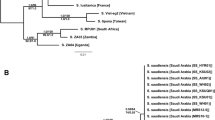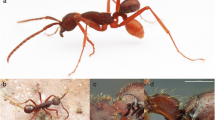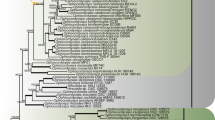Abstract
Leaf-cutting ants (genera Acromyrmex, Amoimyrmex and Atta) are the most important generalist herbivores in the Neotropical Region. The subspecies of Acromyrmex subterraneus are morphologically similar but differing from the other species of this genus. Acromyrmex subterraneus complex may be three non-described leaf-cutting ant species. The taxonomic revision of Acromyrmex subterraneus (Hymenoptera: Formicidae) and of three of its subspecies, A. s. brunneus Forel 1911, A. s. molestans Santschi (1925) and A. s. subterraneus Forel 1893 was made based on its workers and male morphology and genome sequencing with mt-COI and mt-COII. Acromyrmex molestans stat. n., Acromymex brunneus stat. n. and Acromyrmex subterraneus stat. n. are here raised to species. The results of this study contribute to the taxonomic knowledge and reaffirm the complex evolutionary history of leaf-cutting ants.






Similar content being viewed by others
References
Andrade ML (1991) Bionomia e distribuição geográfica do gênero Acromyrmex Mayr, 1865 (Hymenoptera: Formicidae) no Estado de São Paulo, Brasil. Master Degree Thesis. Faculdade de Ciências Agronômicas - UNESP, Botucatu, São Paulo, Brazil pp. 120
AntWeb (2021) Catalog, Bolton World. https://www.antweb.org/browse.do?subfamily=myrmicinae&genus=acromyrmex&rank=genus&resetProject=true. (Retrieved on 18 May 2021)
Bolton B (1995) A new general catalogue of the ants of the world. Harvard UN, Cambridge
Borgmeier TOFM (1950) Estudos sôbre Atta (Hym. Formicidae). Mem Inst Oswaldo Cruz 48:239–292
Borgmeier TOFM (1959) Revision der Gattung Atta Fabricius (Hymenoptera, Formicidae). Stud Entomol 2:321–390
Carvalho AOR (2000) Análise da variabilidade genética e identificação das espécies do gênero Atta (Hymenoptera: Formicidae) por meio de marcadores moleculares. Universidade Federal do Paraná, Curitiba, p 200
Caterino MS, Cho S, Sperling FAH (2000) The current state of insect molecular systematics: a thriving Tower of Babel. Annu Rev Entomol 45:1–54. https://doi.org/10.1146/annurev.ento.45.1.1
Cenis JL, Beitia F (1994) Aplicacion de la tecnica RAPD-PCR (adn polimorfico amplificado al azar) a la identificacion de insectos. Investig Agrar Prod Prot Veg 9:289–297
Chiotis M, Jermiin LS, Crozier RH (2000) A molecular framework for the phylogeny of the ant subfamily Dolichoderinae. Mol Phylogenet Evol 17:108–116. https://doi.org/10.1006/mpev.2000.0821
Cristiano MP, Cardoso DC, Sandoval-Gómez VE, Simões-Gomes FC (2020) Amoimyrmex Cristiano, Cardoso & Sandoval, gen. nov. (Hymenoptera: Formicidae): a new genus of leaf-cutting ants revealed by multilocus molecular phylogenetic and morphological analyses. Austral Entomol 59:643–676. https://doi.org/10.1111/aen.12493
Della-Lucia TMC, Fowler HG, Araújo MS (1993) Castas das formigas cortadeiras. In: Della-Lucia TMC (ed): As formigas cortadeiras. Viçosa: UFV, pp 43–3
Diehl-Fleig E (1995) Formigas: organização social e ecologia comportamental. Editora UNISINOS, São Leopoldo. ISBN 8585580372 pp. 166
Dobler S, Müller JK (2000) Resolving phylogeny at the family level by mitochondrial cytochrome oxidase sequences: phylogeny of carrion beetles (Coleoptera, Silphidae). Mol Phylogenet Evol 15:390–402. https://doi.org/10.1006/mpev.1999.0765
Fowler HG, Ketelhut SM (1993) Confusão taxonômica: variação clinal, inter e intrapopulacional em Acromyrmex subterraneus (Hymenoptera: Formicidae). In: Encontro de Mirmecologia/IV International Symposium on Pest Ants, Belo Horizonte. Belo Horizonte, Minas Gerais, Brazil, p. 14
Fowler HG (1988) Taxa of the neotropical grass-cutting ants, Acromyrmex (Moellerius) (Hymenoptera: Formicidae: Attini). Científica 16:281–295
Fowler HG, Pereira-Da-Silva V, Forti LC, Saes NB (1986) Population dynamics of leaf-cutting ants: a brief review. In: Lofgren CS, Vandemeer RK (eds) Fire ants and leaf-cutting ants. Westview Press, pp 123–145
Galati EAB (1995) Phylogenetic systematics of Phlebotominae (Diptera, Psychodidae) with emphasis on American groups. Boletin De La Direción De Malariología y Saneamento Ambiental 35:133–142
Gonçalves CR (1942) Contribuição para o conhecimento do gênero Atta Fabr., das formigas saúvas. Boletim Da Sociedade Brasileira De Agronomia 5:333–358
Gonçalves CR (1944) Descrição de uma nova saúva brasileira (Hym., Form.). Rev Bras Biol 4:233–238
Gonçalves CR (1961) O gênero Acromyrmex no Brasil (Hym. Formicidae). Stud Entomol 4:113–180
Gonçalves CR (1963) Nota sobre a sistemática de Atta sexdens (L, 1758) e de suas sub-espécies (Hym., Formicidae). Boletim Fitossanitário 9:1–3
Gonçalves CR (1967a) Acromyrmex multicinodus (Forel, 1901), sinônimo de Acromyrmex niger (F. Smith, 1858) (Hymenoptera: Formicidae). Rev Bras Entomol 12:17–20
Gonçalves CR (1967b) As formigas cortadeiras da Amazônia, dos gêneros Atta Fabr. e Acromyrmex Mayr (Hym., Formicidae). In: Lent, H. (ed.). Atas do simpósio sobre a biota amazônica. Zoologia. Rio de Janeiro: Conselho Nacional de Pesquisas 5:181–202
Gonçalves CR (1982) Descrição de Acromyrmex diasi, uma nova especie de formiga cortadeira de folhas. (Hym., Formicidae). Rev Bras Biol 42:485–487
Mayhé-Nunes AJ (1991) Estudo de Acromyrmex (Hymenoptera, Formicidae) com ocorrência constatada no Brasil: subsídios para uma análise filogenética. Master Degree Thesis Universidade Federal de Viçosa - UFV, Viçosa, Minas Gerais, Brasil pp. 120
Nei M (1987) Molecular evolutionary genetics. Columbia University Press, New York
Pacheco P, Berti Filho E (1987) Formigas quenquéns. Formigas cortadeiras e o seu controle. Piracicaba, São Paulo, Brazil pp. 3–17
Rabeling C, Tr S, Bacci M, Bollazzi M (2015) Acromyrmex charruanus: a new inquiline social parasite species of leaf-cutting ants. Insectes Soc 62:335–349. https://doi.org/10.1007/s00040-015-0406-6
Sambrook J, Fritsch EF, Maniatis T (1989) Molecular Cloning: a Laboratory Manual., 2nd edn. Cold Spring Harbor Laboratory Press, New York, pp. 1.626
Santschi F (1925) Revision du genre Acromyrmex Mayr. Rev Suisse Zool 31:355–398
Schultz TR (2000) The origin and evolution of fungus-growing: Clues from the phylogeny of the fungus-growing ants. Abstracts of XXI International Congress of Entomology 2:865
Simon C, Frati F, Beckenbach A, Crespi B, Liu H, Flook P (1994) Evolution, weighting, and phylogenetic utility of mitochondrial gene sequences and a compilation of conserved polymerase chain reaction primers. Ann Entomol Soc Am 87:651–701. https://doi.org/10.1093/aesa/87.6.651
Smith-Caldas MRB, Mcpheron BA, Silva JG, Zucchi RA (2001) Phylogenetic relationships among species of the fraterculus group (Anastrepha: Diptera: Tephritidae) inferred from DNA sequences of mitochondrial cytochrome oxidase I. Neotrop Entomol 30:565–573. https://doi.org/10.1590/S1519-566X2001000400009
Thompson JD, Higgins DG, Gibson TJ (1994) CLUSTAL W: improving the sensitivity of progressive multiple sequence alignment through sequence weighting, position-specific gap penalties and weight matrix choice. Nucleic Acids Res 22:4673–4680. https://doi.org/10.1093/nar/22.22.4673
Wetterer JK (1999) The ecology and evolution of worker size-distribution in leaf-cutting ants Hymenoptera: Formicidae. Sociobiology 34:119–144
Wetterer JK, Schultz TR, Meier R (1998) Phylogeny of fungus-growing ants (Tribe Attini) based on mtDNA sequence and morphology. Mol Phylogenet Evol 9:42–47. https://doi.org/10.1006/mpev.1997.0466
Williams JG, Kubelik AR, Livak KJ, Rafalski JA, Tingey SV (1990) DNA polymorphisms amplified by arbitrary primers are useful as genetic markers. Nucleic Acids Res 18:6531–6535. https://doi.org/10.1093/nar/18.22.6531
Wirthm T, Le Guellec R, Veuille M (1999) Directional substitution and evolution of nucleotide content in the cytochrome oxidase II gene in earwigs (dermapteran insects). Mol Biol Evol 16:1645–1653. https://doi.org/10.1093/oxfordjournals.molbev.a026078
Zolessi LC, Abenante YP (1975) Estudio comparativo de le la genitalia del macho de las especies de Acromyrmex del Uruguay. Rev Biol Urug 3:73–86
Zolessi LC, González LA (1974) Nidificacion y mesoetologia de Acromyrmex en el Uruguay, II Acromyrmex lobicornis (Emery, 1887) (Hymenoptera: Formicidae). Rev Biol Urug 2:37–54
Zolessi LC, González LA (1978) Observaciones sobre el género Acromyrmex en el Uruguay. IV. A. (Acromyrmex) lundi (Guérin, 1838) (Hymenoptera: Formicidae). Rev Fac Human Cienc: Ser Cienc Biol 1:9–28
Zolessi LC, Abenante YP (1973) Nidificacion y mesoetologia de Acromyrmex en el Uruguay. III. Acromyrmex (A). hispidus Santschi, 1925 (Hymenoptera: Formicidae). Rev Biol Urug 1:151–165
Acknowledgements
We would like to thank the support from Conselho Nacional de Desenvolvimento Científico e Tecnológico (CNPq) (Grant No. 301167/2003-6) and “Programa Cooperativo sobre Proteção Florestal (PROTEF) do Instituto de Pesquisas e Estudos Florestais (IPEF)” for financial support.
Author information
Authors and Affiliations
Contributions
LCF, APPA and RSC conceived and designed the experiment; LCF, APPA and RSC performed the investigation; LCF, APPA and RSC performed data analyses; LCF, APPA, RSC, TMMMF, TTS, JCZ, KKAS an NC wrote the original draft; RSC, TMMMF an JCZ reviewed and edited the document.
Corresponding author
Ethics declarations
Conflict of interest
The authors declare no conficts of interest.
Additional information
Publisher's Note
Springer Nature remains neutral with regard to jurisdictional claims in published maps and institutional affiliations.
Rights and permissions
About this article
Cite this article
Forti, L.C., Andrade, A.P.P., da Silva Camargo, R. et al. Taxonomic revision of the leaf-cutting ant Acromyrmex subterraneus (Forel, 1893). Int J Trop Insect Sci 42, 2897–2908 (2022). https://doi.org/10.1007/s42690-022-00815-5
Received:
Accepted:
Published:
Issue Date:
DOI: https://doi.org/10.1007/s42690-022-00815-5




